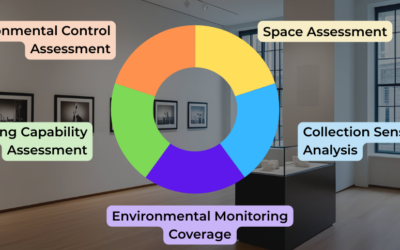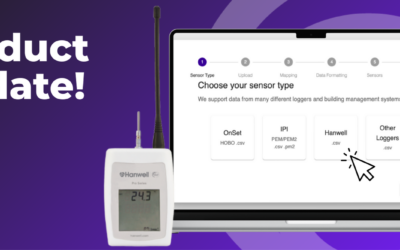Data loggers are devices that measure and record environmental parameters such as temperature, humidity, light, and vibration. As opposed to manual spot checkers, they do so continuously, providing data for graphs and comparisons over time. They are essential tools for collections care professionals who want to monitor and protect their collections from deterioration and damage.
However, data loggers are not infallible. They will naturally drift over time and produce inaccurate readings if they are not calibrated (or sometimes replaced) regularly. Calibration can have different definitions depending on how technically precise we want to be. Strictly speaking, calibration does not actually include readjustment of a device, simply comparison against a standard. If your calibration services do not include readjustment, check out this blog post by Angelica Isa on what you’re supposed to do with your calibration certificates.
For our purposes, we will define it as the process of comparing the data logger’s readings with a known standard and adjusting them if necessary. In this blog post, we will discuss some of the best practices for data logger calibration for collections care.
Choose the right calibration method and frequency
There are two main methods for data logger calibration: field calibration and laboratory calibration. Field calibration is done on-site using portable equipment and reference standards. It is convenient and cost-effective, but it may not be as accurate or reliable as laboratory calibration. Laboratory calibration is done by sending the data logger to a certified facility that uses specialized equipment and traceable standards. It is more accurate and reliable, but it may take longer and cost more.
If you are interested in using saturated salts, check out this guideline from the AIC wiki on setting up calibration salt chambers to check your data loggers.
The frequency of calibration depends on several factors, such as the type and quality of the data logger, environmental conditions, the manufacturer’s recommendations, and the user’s requirements. Generally, data loggers should be calibrated at least once a year, or more often if they are used in harsh or unstable environments, or if they show signs of drift or malfunction. Use Angelica’s blog post to help you decide if you should increase or decrease the period in between calibration services.
Follow the manufacturer’s instructions and specifications
Each data logger has its own specifications and instructions for calibration. These may include the required equipment, procedures, settings, tolerances, and documentation. It is important to follow the manufacturer’s instructions and specifications carefully to ensure that the calibration is done correctly and consistently. If the instructions or specifications are unclear or missing, contact the manufacturer or a qualified service provider for assistance. Testo and Hanwell, for example, both have separate calibration services for their equipment. Conserv includes calibration and readjustment in its subscription (but it is not a certified ISO laboratory).
Use appropriate reference standards
Reference standards are devices or materials that have known or assigned values of the parameters that are being measured by the data logger. For example, a thermometer with a known temperature or a hygrometer with a known humidity. Reference standards should be traceable to national or international standards (such as ISO) to ensure their accuracy and reliability, so make sure you check that the lab you are using is using a standard appropriate to your region.
It is possible that the lab you choose for your calibration services will give you options for reference points. It is normal to use 2-point or 3-point calibration for temperature and humidity data logger calibration. This means that your device will be compared to 2 or 3 different known readings to see if it performs differently at varying temperatures/relative humidities. If you are given the choice for which points to use, pick the ones that are similar to the environment where your data logger normally lives and make sure you get as close as you can to the upper and lower extremes you experience.
Document and verify the calibration results
Documentation can be an essential part of a calibration service you are paying for depending on your needs. It provides evidence that the calibration was done properly and that the data logger is within its specifications. Documentation should include information such as the date and time of calibration, the reference standards and equipment used, the procedures followed, the readings obtained, the adjustments made, and any errors or deviations observed. Depending on the service you hire, your calibration may include a calibration certificate or report that summarizes the results and confirms that the data logger meets its specifications according to certain international standards.
Some institutions will require you to do laboratory calibrations with standardized calibration certificates as they will audit your lab to make sure your data loggers are working as you say they are. Your museum might use these certificates to ensure quality in their own processes, as this is the evidence that you are following industry standards. This will vary across collections and will depend on internal policies and practices, so make sure you know what you need before you send your equipment to a service that is too expensive for what you want or to a service that works just fine but will not give you the official certification you require.
Verification is the process of checking that the data logger is functioning correctly after calibration. Verification can be done by comparing the data logger’s readings with another calibrated device or reference standard under similar conditions. Verification should be done before returning the data logger to service.
Maintain good calibration practices
Remember that calibration is not a one-time event. It is an ongoing process that requires regular maintenance and quality control. Unfortunately, it is not advisable to buy a data logger and then forget about it and trust all its numbers as the years go by. This could lead to bad decision-making regarding the management of your collections environment.
Some good calibration practices include:
- Store and handle your data loggers carefully to avoid physical damage or contamination.
- Check data loggers periodically for signs of drift or malfunction. Keep an eye on your graphs to make sure your sensors are acting in a more or less predictable way. Of course, keep in mind that your sensors are there to warn you of spikes and changes in your environment, so before you decide there must be something wrong with the data loggers, check your spaces to see if your sensors are actually warning you about undesirable environmental changes.
- If possible, label data loggers with their calibration dates and status. Some services will add their own sticker to your device with this information. Make sure the stickers don’t obstruct the sensors.
- Keep track of calibration records and schedules. This way, you will know when you are due for maintenance and be able to tell if you are getting services too often (or too seldom!).
- Review calibration results and identify any trends or issues.
- Implement corrective actions if necessary. It may sometimes become necessary to replace your data loggers altogether.
- Seek professional advice if in doubt.
Train relevant staff to understand data logger calibration practices
Make sure the collections care professionals who deal with the environmental monitoring data and devices know the basics of calibration practices. While calibration can get very technical very fast and all staff do not need to be aware of the nitty gritty details of sensor readjustment, there are some basics that everyone should be familiar with. For example:
- Sensors in data loggers can drift over time and need to be checked and replaced. Once a year is a good place to start, but this period can be adjusted based on how your sensors do each time.
- Calibration does not necessarily include readjustment and this must be clear when contracting a service to check your data loggers.
- If readjustment is not included, your readings will have to be corrected for error with the numbers provided in your calibration certificate. Remember this will add more time to your monitoring activities, particularly when you have several devices to check, and therefore, several readings to adjust.
- All sensors come with a +- acceptable deviation so when you compare data loggers to each other, they can both be within acceptable manufacturer ranges and still read very differently from each other due to the acceptable deviations being stacked.
- It is possible to do basic checks of your sensor readings with saturated salt solutions in a basic laboratory setting.
- Some brands of data loggers cannot be readjusted (only calibrated), and some brands will simply need to be replaced anew when their readings go too far off what’s acceptable. Make sure you ask your supplier about this before you commit to buying a device or you might find yourself having to replace it entirely in less than a decade.
Data logger calibration can be a critical aspect of your collections care practices as they ensure that environmental data collected is both accurate and reliable. By following these best practices, you can ensure that your data loggers are well maintained and supporting the work you do to preserve collections.
If all this calibration business is too much hassle to add to your busy work schedule, and you’d rather someone else takes care of it, reach out to us! Conserv includes calibrations and sensor replacements in its annual subscription.
If you have any questions about environmental monitoring, integrated pest management, or just want to talk about preventative conservation, please reach out to us! Don’t forget to check out our blog or join our community of collections care professionals where you can discuss hot topics, connect with your peers or even take a course to get familiar with the Conserv platform.




